Linden D., Reddy T.B. (eds.) Handbook of batteries
Подождите немного. Документ загружается.

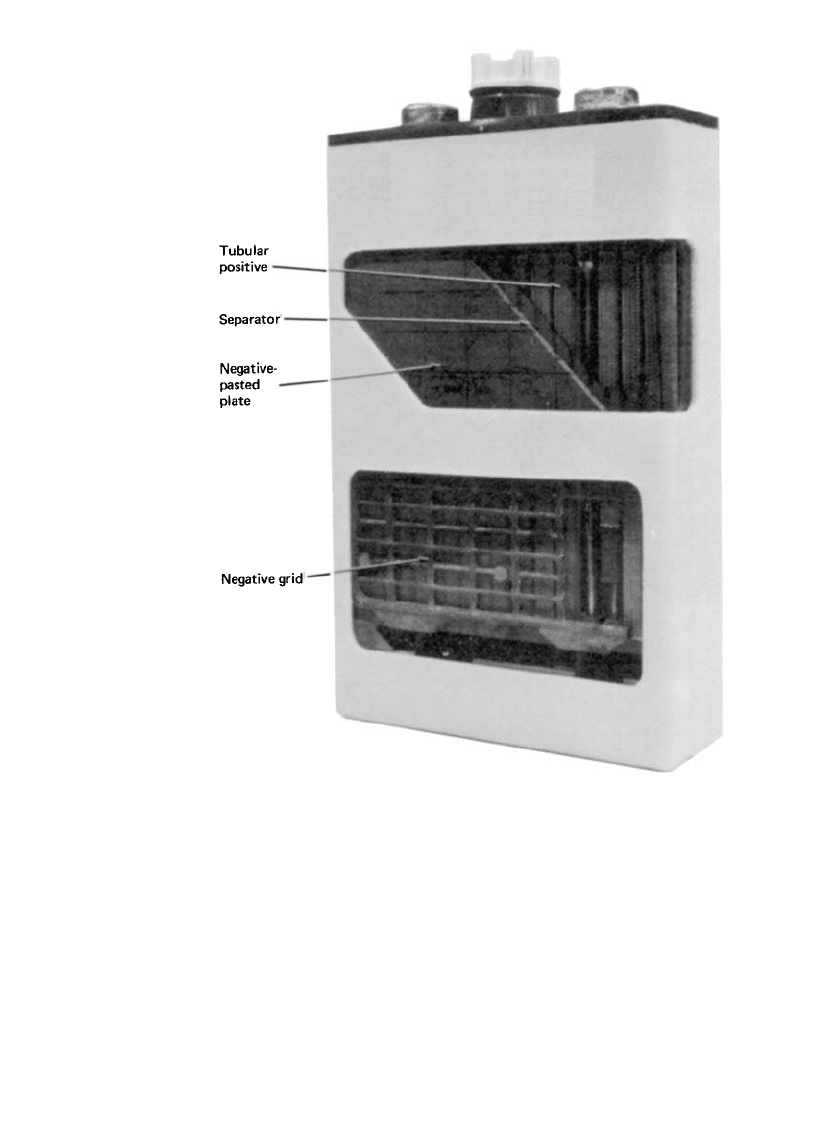
23.46 CHAPTER TWENTY-THREE
FIGURE 23.25 Lead-acid cell with tubular positive plates. (Courtesy of Ener-
sys, Inc.)
Small traction batteries (such as for golf carts) are designed to be intermediate between
full-sized traction batteries and SLI batteries. Traction design concepts sometimes utilized
include high paste density, careful control of plate curing and formation, to maximize content
of the positive plates, glass matting against the positive, and tubular positives. SLI concepts
sometimes utilized for golf-cart and other electric-vehicle batteries include thin cast radial
grids, minimum separator resistance, through-the-partition intercell connection, and heat or
epoxy-sealed plastic cases and covers. Cost is also an important factor.
For on-the-road electric-vehicle applications, the major criterion has been high energy
density, which results in maximum range, and SLI battery design has prevailed over traction
battery design. In traditional cycling batteries with a few widely spaced plates, good elec-
trolyte homogeneity occurs by convective flow. When plates are made thinner and more
closely spaced for high-discharge-rate applications, such as for electric vehicle propulsion,
the electrolyte has been found to become stratified during operation. A variety of electrolyte
mixing devices has been designed not only to offset stratification but also to increase the
discharge efficiency of the battery.
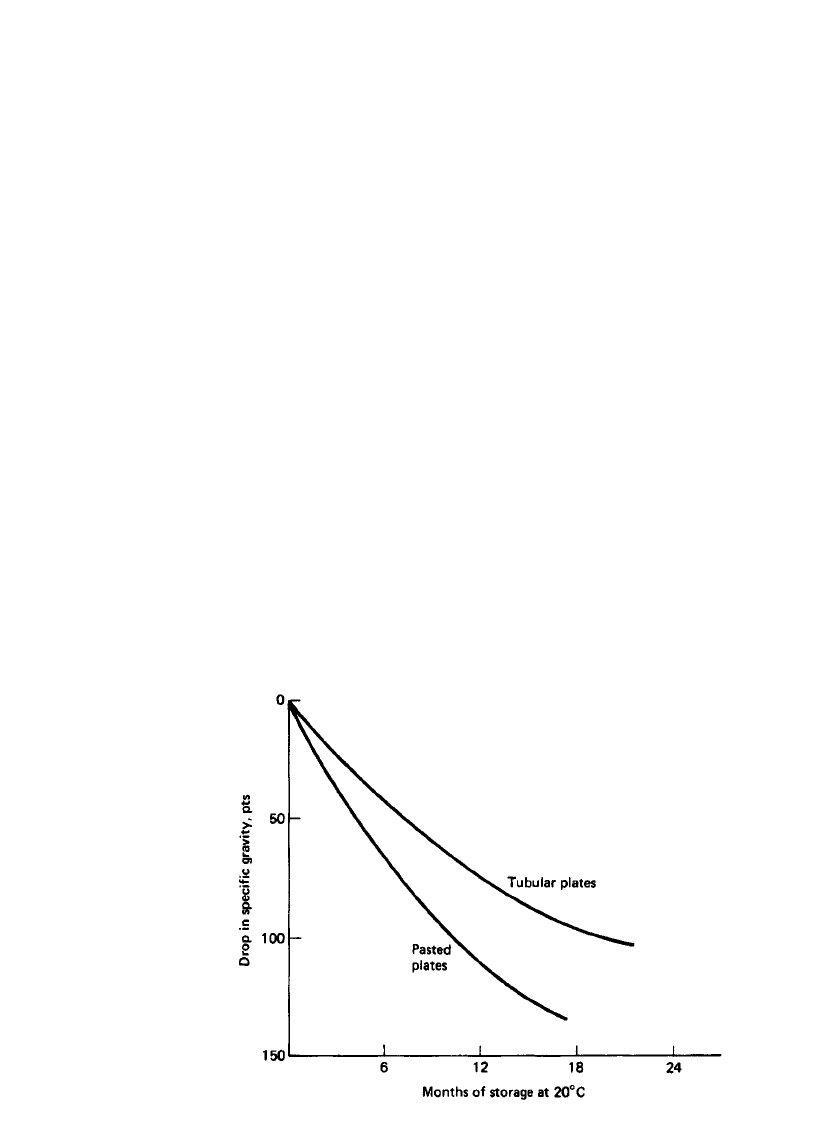
LEAD-ACID BATTERIES 23.47
FIGURE 23.26 Retention of charge of pasted- vs. tubular-plate traction
batteries.
Military submarines of the diesel-electric type require cycling batteries for propulsion.
These batteries are made with nonantimonial lead grids because stibine and arsine produced
on charge are unacceptable for personnel health in a closed environment. The plates are
much larger than most traction cells—up to 600 cm wide and up to 1500 cm tall. Both flat-
pasted and tubular positive plates are used.
23.5.2 Performance Characteristics
Batteries for traction and deep-cycle applications use cells with either pasted or tubular
positive plates. In general, the performance of the two types of plates is similar, but the
tubular or gauntlet plates show lower polarization losses because of the larger active surface
area, better retention of the positive active material, and reduced loss on stand. The loss of
capacity on stand at room temperature for the two plate structures, as measured by the drop
in specific gravity, is shown in Fig. 23.26.
Typical discharge curves for the two types of traction cells are shown in Fig. 23.27. The
relationship of discharge current to Ampere-hour capacity, up to various end voltages, is
shown in Fig. 23.28. These data are presented on the basis of the positive plate since cell
design and performance data of traction batteries are generally based on the number and
size of positive plates that are in the cell. As is typical with most batteries, the capacity
decreases with increasing discharge load and increasing end voltage.
The same relationship and comparison of the performance of the pasted and tubular plates
are plotted in Fig. 23.29. These data show the superiority of the tubular plate as the discharge
rate is increased.
Figure 23.30 shows the increase in available service on intermittent discharge, carried out
over different periods, as compared with a continuous discharge. The gain is more pro-
nounced at the heavier discharge loads and when the intermittent discharge is spread out
over a longer period, thus allowing more time for recovery.
The effect of temperature on the discharge performance of traction-type batteries is illus-
trated in Fig. 23.31.
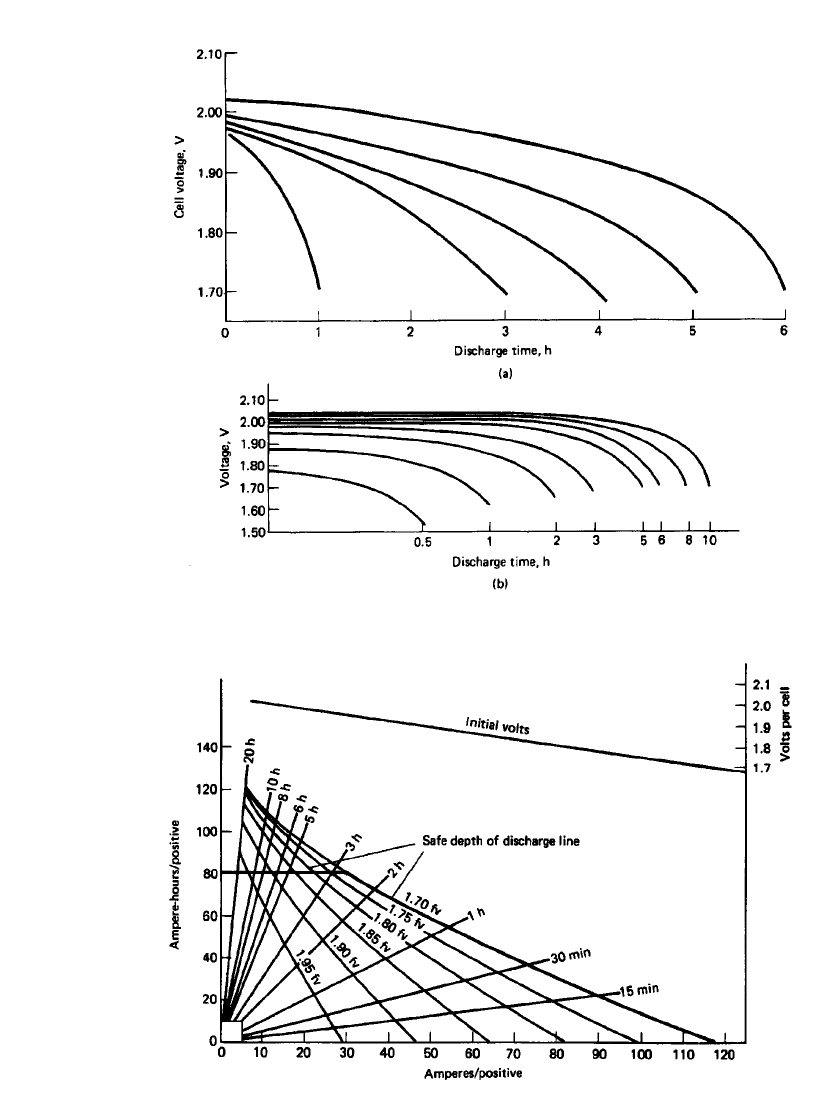
23.48 CHAPTER TWENTY-THREE
FIGURE 23.27 Discharge characteristics of traction batteries at 25⬚C. (a) Flat-pasted-plate
batteries. (b) Tubular positive batteries.
FIGURE 23.28 Performance characteristics of industrial flat-pasted plate traction battery to
various final voltages (fv), at 25⬚C based on positive plate rated at 100 Ah at 6-h rate.
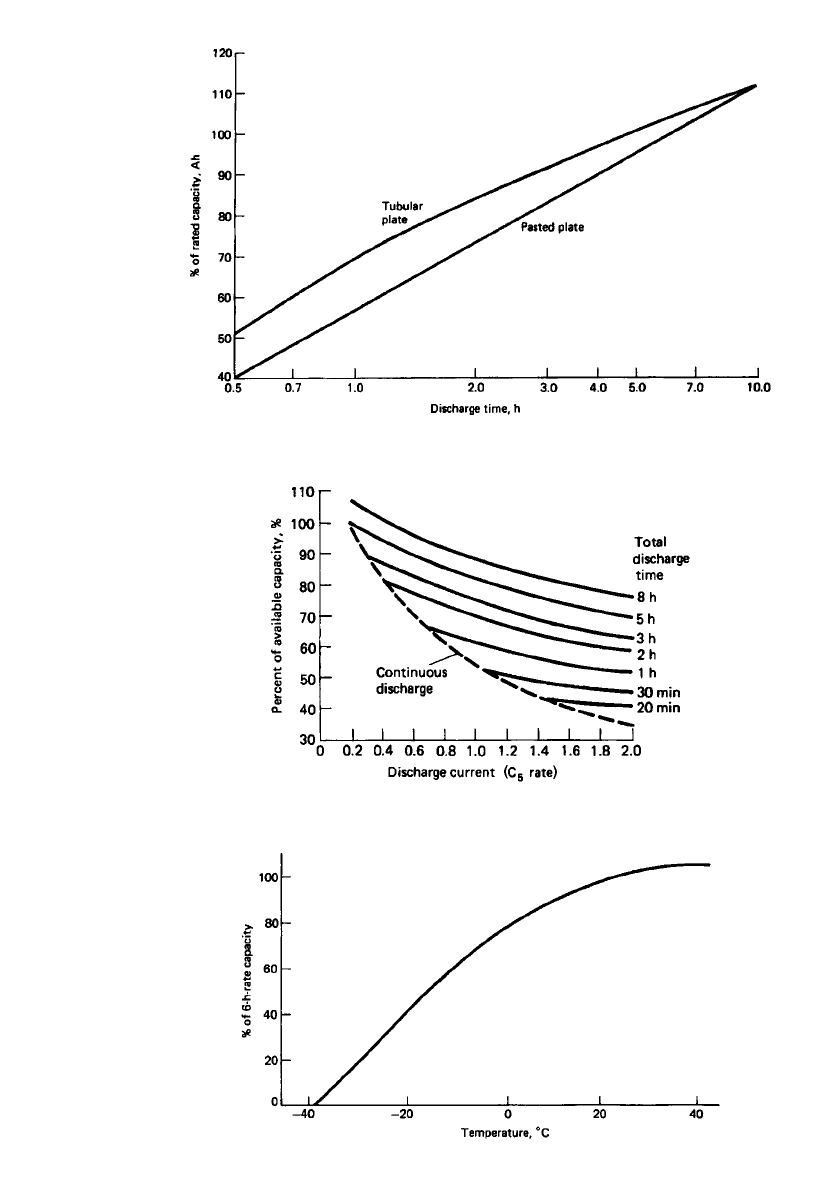
LEAD-ACID BATTERIES 23.49
FIGURE 23.29 Effect of discharge rate on capacity of traction batteries at 25⬚C. Com-
parison of performance of flat-pasted-plate vs. tubular-plate batteries.
FIGURE 23.30 Capacity available on intermittent discharge of
traction batteries at 25⬚C.
FIGURE 23.31 Effect of temperature on capacity of traction batteries,
typical flat-plate design. (From Ref. 23.)
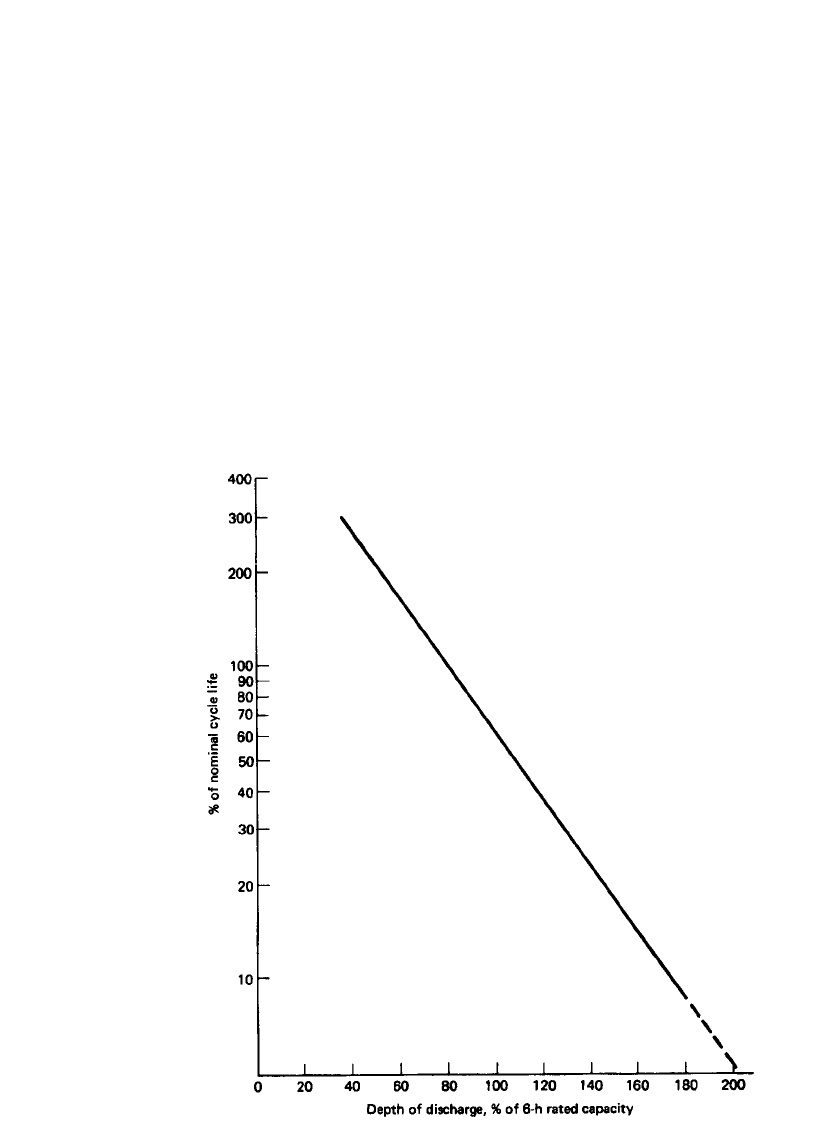
23.50 CHAPTER TWENTY-THREE
FIGURE 23.32 Cycle life vs. depth of discharge of traction batteries.
The cycle life characteristics of traction batteries are presented in Fig. 23.32. This figure
shows the relationship of cycle life to depth of discharge at the 6-h discharge rate, cycle life
being defined as the number of cycles of 80% of rated capacity. It is quite evident that the
deeper the cells are discharged, the shorter their useful life, and that 80% depth of discharge
should not be exceeded if full life expectancy is to be attained. Figure 23.28 shows the safe
depth of discharge for other discharge rates. At low rates the discharge should be terminated
at the higher end voltages as shown, until the 1.70-V line is intercepted; then the discharges
at the higher rates can be run to 1.7-V per cell final voltage. Typical cycle life expectancy
is 1500 cycles (approximately 6 years).
The relationship of discharge current and service time for several small deep-cycling
batteries is shown in Fig. 23.33. At very high discharge rates, Peukert’s relationship does
not hold as well as for the SLI types, and the performance deviates at shorter discharge
times. Nevertheless, such deep-cycling batteries can be used for cranking service and may
be preferred if the battery will be deeply or repeatedly discharged in operation. Conversely,
an SLI battery generally makes a poor deep-cycling battery; SLI batteries are usually made
with nonantimonial lead grids (U.S. practice), and cycling generally causes the development
of a grid-active material barrier layer which shortens cycle life. A comparison of the cycle
life at a low discharge rate (25 A) of an SLI battery with a deep-cycle design of the same
physical size is shown in Fig. 23.34.
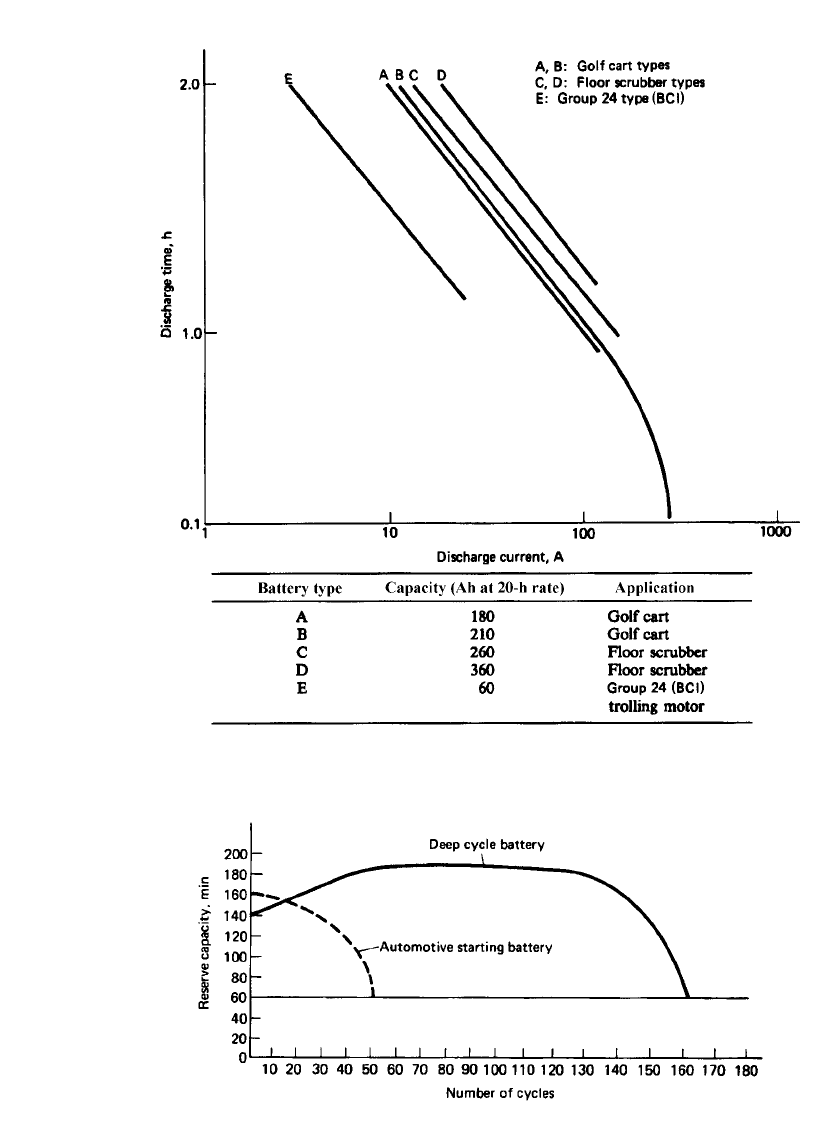
LEAD-ACID BATTERIES 23.51
FIGURE 23.33 Performance of electric-vehicle batteries.
FIGURE 23.34 Cycle life characteristics at low discharge rate (25 A) for deep-cycle
vs. SLI-type batteries.

23.52 CHAPTER TWENTY-THREE
23.5.3 Cell and Battery Types and Sizes
Traction or motive-power batteries are made in many different sizes, limited only by the
battery compartment size and the required electrical service. The basic rating unit is the
positive-plate capacity, given in Ampere-hours at the 5- or 6-h rate. Table 23.14a lists the
typical U.S. traction plate sizes using flat-pasted plates; between 5 and 33 plates are used to
assemble traction cells, as also shown in the table. Ratings of the cell are the product of the
capacity of a single positive plate multiplied by the number of positive plates. The cells, in
turn, are assembled in a variety of battery layouts, with typical voltage in 6-V increments
(e.g., 6, 12, 18 to 96 V) resulting in almost 1000 battery sizes. Popular traction battery sizes
are the 6-cell, 11-plates-per-cell, 75-Ah positive-plate (375-Ah cell) and the 6-cell, 13 plates-
per-cell, 85-Ah positive-plate (510-Ah cell) batteries. Table 23.14b presents similar infor-
mation on the tubular positive-plate batteries.
Several SLI group sizes have been used for deep-cycling applications, especially taller
versions of otherwise SLI lengths and widths. Some of these are listed in Table 23.15.
A variation of the forklift battery design is used for some on-the-road electric vehicles.
Table 23.16 lists the characteristics of typical electric-vehicle batteries. Manufacturers’ cat-
alogs and data should be consulted for specific information on sizes and performance.
TABLE 23.14a Typical Traction Batteries (United States), Flat-Pasted Plates
Positive-
plate
capacity,
Ah at
6-h rate
Plate dimensions, mm
Height
Width
Positive Negative
Thickness
Positive Negative
Cell size, *†
(positive
plates
per cell)
45 275 143 138 6.5 4.6 5–16
55 311 143 138 6.5 4.6 5–16
60 330 143 138 6.5 4.6 5–16
75 418 143 138 6.5 4.6 2–16
85 438 146 146 7.4 4.6 3–16
90 489 138 143 6.5 4.6 3–16
110 610 143 143 7.4 4.6 4–12
145 599 200 200 6.5 4.7 4–10,12,15
160 610 203 203 7.2 4.7 4–10,12,15
*All cells have n positive plates and n ⫹ 1 outside negative plates.
†Typical cell characteristics: Six positive, 85-Ah plates (510-Ah cell); weight: 45 kg; size: length, 127 mm; width,
159 mm; height, 616 mm.
Source: C & D Technologies.

LEAD-ACID BATTERIES 23.53
TABLE 23.14b Typical Traction Batteries, Tubular Plates
Positive-
plate
capacity,
Ah at
6-h rate
Dimensions, mm
Height
Width
Positive Negative
Thickness
Positive Negative
Cell size, †,‡
(positive
plates
per cell)
49 249 147 144 9.1 * 4–10
55 258 147 144 9.1 * 4–10
57 300 147 144 9.1 * 4–10
75 344 147 144 9.1 * 4–10
85 418 147 144 9.1 * 4–10
100 445 147 144 9.1 * 4–10
110 565 147 144 9.1 * 4–10
120 560 147 144 9.1 * 4–10
170 560 204 203 9.1 * 3–8
*Varies from 5 to 8 mm depending on manufacturer.
†All cells have n positive and n
⫹ 1 outside negative plates. Negatives are flat-pasted plates.
‡Typical cell characteristics; six positive, 85-Ah plates (510-Ah cell); weight: 36 kg; size: length, 127 mm; width,
157 mm; height, 549 mm.
Source: Enersys, Inc.
TABLE 23.15 Small Deep-Cycling Batteries
BCI type Volts
Dimensions,
mm
L W H Ratings
Typical
operational
current,
A
Applications
U1
24
27
12
12
12
197
260
306
132
173
173
186
225
225
30–45Ahat20h
75–90Ahat20h
90–105 Ah at 20 h
25
25
冧
25
Trolling
motors
Wheelchairs
GC2
(GC2H)
Not assigned
Not assigned
6
6
6
12
264
264
264
261
183
183
183
181
260
260
260
279
75 min at 75 A
95–90 min at 75 A
100–100 min at 75 A
105 Ah at 20 h
75 (GC)
300 (EV)
300 (EV)
冧
150 (EV)
Golf carts
Electric
vehicles
Not assigned
Not assigned
6
12
295
241
178
166
276
239
200–230 Ah at 20 h
50–70Ahat20h
50–75
冎
50–75
Floor
maintenance
machinery
Not assigned 12 518 276 445 350–400 Ah at 20 h 30–50 Mine cars
Source: BCI Technical Committee, Battery Council International.
TABLE 23.16 Typical Electric Vehicle (EV) Batteries
BCI
group Volts
Plates
per
battery
Maximum overall
dimensions, mm
Length Width Height
Weight,
kg
Ah at
2h
Ah at
3h
75 A
(min)
Wh/kg
at 3-h
rate
U1 12 54 197 132 186 95 20 22 15 26
24 12 78 260 173 225 22 55 59 39 31
GC2 6 57 264 183 270 26 126 135 100 29
27 12 90 306 173 225 24 62 68 45 32
GC2 6 57 264 183 270 30 150 171 120 33
GC2 6 39 264 183 280 27 158 174 140 37

23.54 CHAPTER TWENTY-THREE
23.6 STATIONARY BATTERIES: CONSTRUCTION AND
PERFORMANCE
23.6.1 Construction
Designs for stationary batteries have changed much more slowly than those for SLI and
traction batteries. This is not surprising in light of the much longer service life of the sta-
tionary batteries. Heavy, thick plates (including Plante´ as well as pasted Faure and tubular
positives) with high paste density are generally used.
24
Curing is very important, and pasted
plates are usually carefully dried to prevent cracks and degradation of the grid-paste interface.
The stationary battery is designed with excess electrolyte (highly flooded) to minimize
maintenance and the watering interval and is generally positive-plate-limited in capacity
(compared with traction batteries, for example, which are electrolyte- or acid-limited). The
stationary batteries are capable of being floated and moderately overcharged.
The thick-plate design of stationary batteries reflects the fact that high energy and power
densities are not as necessary as is the case for SLI and traction batteries. The overcharge
operation of stationary batteries requires a large electrolyte volume (which can be accom-
modated as the batteries are mounted in fixed positions) and usually nonantimonial lead grids
(to maximize the intervals between watering). The overcharge causes some positive-grid
corrosion, and this is manifested as ‘‘growth’’ or expansion of the grid. The dimensions from
the positive plate to the inside container are scaled so that the positives can grow by up to
10% before the plates touch the container walls. If the growth is greater than 10%, the active
material is sufficiently loose on the grid so that the capacity becomes severely positive-
limited and the battery must be replaced.
The positives are usually supported from hanging lugs or nonconductive rods, which are
borne by the tops of the negatives. The containers are usually transparent thermoplastics
(acrylonitrile-butadiene-styrene, styrene-acrylonitrile resin, polycarbonate, PVC), but some
small stationary batteries are built in translucent polyolefin containers similar to those used
for SLI batteries. The stationary batteries were the first application for flame-retardant vent
caps which are now also standard on most SLI batteries.
The positive plate has the greater influence on the performance and life of the battery. A
variety of positives are used, depending as much on tradition and custom as on the perform-
ance characteristics. The flat-pasted stationary batteries are popular in the United States
because of their lower costs, lower maintenance, and lower generation of hydrogen. Lead-
calcium tubular plates are now being introduced. For most of the standby emergency appli-
cations the grids are cast in lead-calcium alloy. Plante´ and tubular designs are popular in
Europe because of their longer life. All stationary batteries today use pasted negative plates
generally with n positive plates and n
⫹ 1 negative plates (outside-negative design). This is
done because of the need for proper support of the positives, which tend to grow or expand
during their life. One design used by some manufacturers is to make the two outermost
negative plates thinner than the inside negative plates because the outermost surfaces are not
easily recharged. Figure 23.35 is an illustration of a stationary battery system installation.
A significantly different approach to stationary battery design is the cylindrically shaped
battery of Lucent Technologies (formerly AT&T Bell Laboratories).
25,26
Traditionally, pris-
matic-shaped stationary batteries had failed after 5 to 20 years of service in telephone sys-
tems. The battery, illustrated in Fig. 23.36, incorporates a number of innovations in order to
achieve a battery life initially predicted to be 30 years or longer. These include lattice-type
circular-shaped pure lead grids (cupped at a 10
⬚ angle), plates stacked horizontally one above
the other instead of in the conventional vertical construction, chemically produced tetrabasic
lead sulfate (TTB) positive paste, positives welded around the external plate circumference,
negatives welded to a central conductor core, and heat-sealed copolymer container and cover.
The use of pure lead in place of lead-calcium is to reduce positive-plate grid growth; the
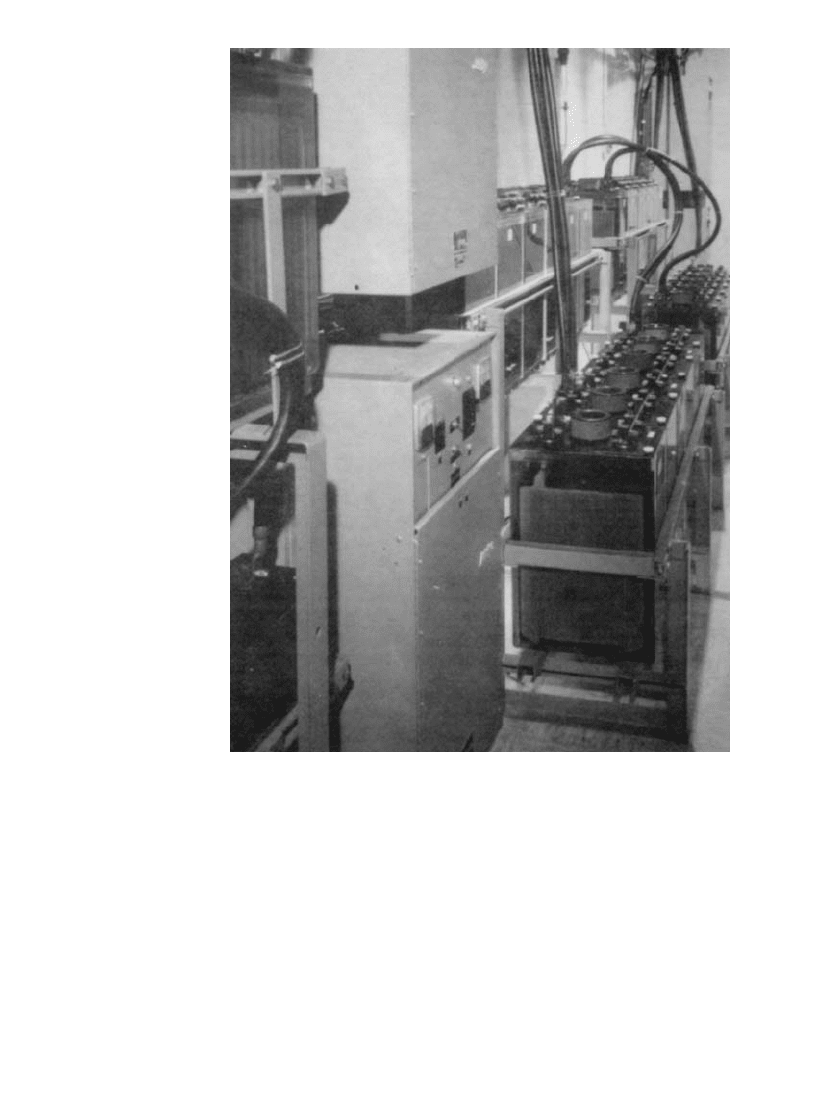
LEAD-ACID BATTERIES 23.55
FIGURE 23.35 Stationary battery system installation.
circular and slightly concave shape of the plates is to counter the effect of growth and ensure
good contact of the active material and grid during the life of the battery. An alloy of
Pb/Sn
28,35
prevents positive terminal post corrosion (nodular) and postseal leakage for the
life of the cell. Twenty-year-old batteries with this alloy have shown no nodular corrosion
and no post-seal leakage. Grid growth is caused by the conversion of lead into PbO
2
on the
grid surfaces and at the grain boundaries. The formation of this PbO
2
on the grid adds to
the amount of active paste material of the plate and, in the case of concentric grid,
27
increases
the plate capacity over time. The Bell Labs researchers
12
found that the growth of the pos-
itive-grid members is proportional to their surface area and inversely proportional to their
cross-sectional area. Maintaining this ratio of surface area to cross-sectional area for the
concentric members in the grid is accomplished by varying the cross section and the surface
areas. Thus the shape of the grid remains constant and the only change is caused by the
formation of the lead dioxide on the lead grid surfaces.
